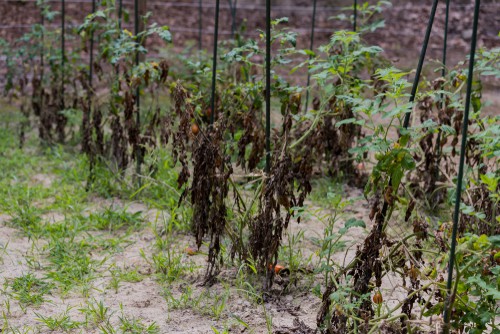Tomatoes are one of the most beloved garden vegetables, but they can be fickle plants. One of the most frustrating problems that tomato growers face is tomato plant dying from top down. This can be a sign of a serious issue that needs to be addressed promptly, or it could be a minor problem that can be easily fixed.
Understanding the problem of tomato plants dying from the top down is crucial for any gardener who wants to grow healthy and productive tomato plants. This problem can be caused by a variety of factors, including pests, diseases, environmental stress, and nutrient deficiencies.
Identifying the cause of the problem is the first step in finding a solution and preventing further damage to the plant.
Key Takeaways
- Tomato plants are prone to dying from the top down, which can be caused by a variety of factors.
- Identifying the cause of the problem is crucial for finding a solution and preventing further damage to the plant.
- Preventive measures, such as proper watering, fertilization, and pest control, can help keep tomato plants healthy and productive.
Also see:
Understanding The Problem
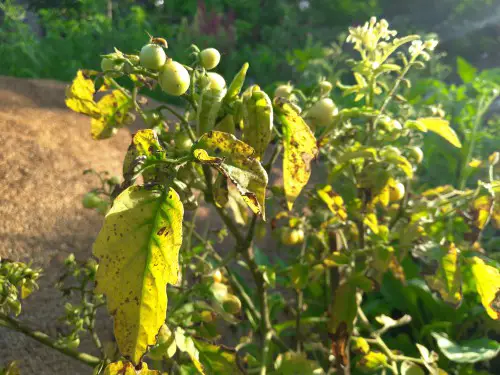
When tomato plants start dying from the top down, it is a clear indication that there is an issue with the plant. The first sign of a problem is usually a yellowing of the leaves, followed by wilting and eventually death of the entire plant.
There are several factors that can cause this issue, including fungal wilt diseases, such as Fusarium wilt and Verticillium wilt, as well as viral diseases like the Tomato Spotted Wilt Virus. These diseases infect the vascular system of the plant, blocking the flow of water and nutrients, which leads to wilting and death.
In addition to diseases, environmental factors can also cause tomato plants to die from the top down. For example, a lack of water can cause wilting and yellowing of the leaves. On the other hand, overwatering can lead to root rot, which can also cause the plant to die.
It is important to note that the issue with the plant may not always be visible on the leaves or stem. Infected leaves may not show any signs of the disease, and the stem and branches may appear healthy. In some cases, the entire plant may appear healthy, but it will still die from the top down.
To determine the cause of the issue, it is essential to examine the entire plant, including the roots. If the roots are brown and have streaking, it is a clear indication of a fungal disease. If the roots are healthy, it is more likely to be an environmental factor.
Tomato Plant Dying from Top Down – 4 Common Problems
Tomato plants are a popular choice for many gardeners, but they can be susceptible to various problems that can cause them to die from the top down.
Understanding the common causes of tomato plant death can help gardeners take preventive measures to keep their plants healthy. The following are some of the most common causes of tomato plant dying.
1. Disease and Fungal Infections

Diseases and fungal infections are among the most common causes of tomato plant death. Some of the most common diseases that can cause tomato plant death include blight, early blight, southern blight, fusarium, and verticillium wilt. These diseases can cause the leaves of tomato plants to turn yellow, wilt, and die.
Fungi can also cause tomato plant death, particularly in humid or wet conditions. Gardeners can prevent the spread of disease by practicing good sanitation, such as removing dead or diseased plant material and avoiding overhead watering.
2. Environmental Stress
Environmental stress can also cause tomato plant death. High temperatures, lack of sunlight, drought, and other environmental factors can all stress tomato plants and cause them to die from the top down.
Heat stress can cause tomato plants to wilt and die, while lack of sunlight can lead to stunted growth and poor fruit production. Drought stress can cause tomato plants to wilt and die, and gardeners should ensure that their plants receive adequate water.
3. Nutrient Deficiencies
Nutrient deficiencies can also cause tomato plant death. Calcium, nitrogen, and phosphorous deficiencies are among the most common nutrient deficiencies that can cause tomato plant death.
Calcium deficiency can cause blossom end rot, a condition where the bottom of the tomato fruit turns black and mushy. Nitrogen and phosphorous deficiencies can cause stunted growth and poor fruit production. Gardeners should ensure that their plants receive adequate nutrients by fertilizing their plants regularly.
4. Pests and Other Threats
Pests and other threats can also cause tomato plant death. Stalk borers can damage tomato plants and cause them to die from the top down. Walnut trees can also be toxic to tomato plants, and gardeners should avoid planting tomato plants near walnut trees.
Gardeners should also watch out for other pests, such as aphids, mites, and whiteflies, which can damage tomato plants and cause them to die from the top down.
Symptoms and Diagnosis
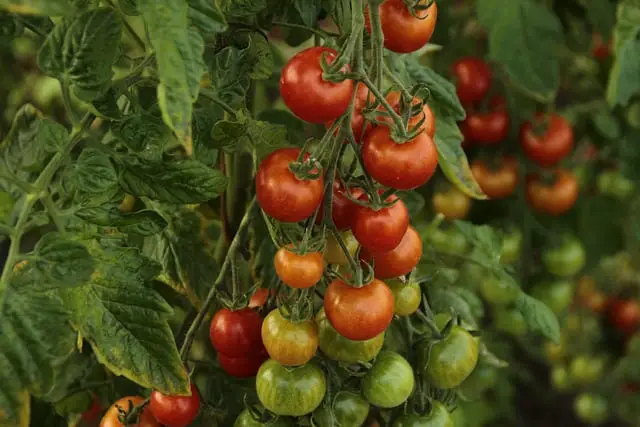
When a tomato plant is dying from the top down, it is important to identify the symptoms and diagnose the problem quickly. The most common symptom of this problem is yellowing and wilting of the top leaves of the plant.
The foliage may also become discolored, with dark green leaves turning yellow or brown. In some cases, the lower leaves of the plant may also die off.
One possible cause of this problem is fungal wilt diseases, such as verticillium wilt. These diseases attack the vascular system of the plant, causing brown streaking and discoloration in the stem. Infected leaves may also show signs of discoloration and wilting.
Another possible cause of top-down dying in tomato plants is the tomato spotted wilt virus. This virus is spread by thrips and can cause yellowing and wilting of the top leaves of the plant. Infected leaves may also show brown streaking and other signs of discoloration.
To diagnose the problem, it is important to examine the plant closely and look for any signs of disease or infestation. If the stem of the plant shows signs of brown streaking or discoloration, it is likely that the problem is caused by a fungal wilt disease.
If the plant is also showing signs of thrips infestation, it is possible that the problem is caused by the tomato spotted wilt virus.
In some cases, it may be necessary to send a sample of the plant to a laboratory for testing to determine the exact cause of the problem. Once the problem has been diagnosed, appropriate measures can be taken to treat the plant and prevent further damage.
Preventive Measures and Solutions
Tomato plants dying from the top down can be a frustrating experience for gardeners. However, there are several preventive measures and solutions that can help keep your tomato plants healthy and thriving.
1. Appropriate Watering and Drainage

One common cause of tomato plants dying from the top down is overwatering or poor drainage. To prevent this, it is important to water your tomato plants appropriately. In general, tomato plants require about 1-2 inches of water per week, either from rainfall or irrigation.
However, it is important to avoid watering the plants too much or too little, as both can lead to problems.
To ensure proper drainage, it is important to plant your tomato plants in well-draining soil. If you are growing tomatoes in pots, make sure to use a high-quality potting mix that contains perlite or vermiculite to improve drainage. Additionally, you can add a layer of gravel or sand to the bottom of the pot to help excess water drain away.
2. Proper Soil and Fertilizer Use
Tomato plants require nutrient-rich soil to grow and thrive. To ensure that your tomato plants are getting the nutrients they need, it is important to use a high-quality soil mix that contains organic matter, such as compost or aged manure.
Additionally, you can fertilize your tomato plants with a balanced fertilizer that contains equal parts nitrogen, phosphorus, and potassium.
However, it is important to avoid over-fertilizing your tomato plants, as this can lead to nutrient burn and other problems. To prevent this, follow the instructions on the fertilizer package carefully, and avoid applying fertilizer too close to the stem of the plant.
3. Effective Crop Rotation
Another way to prevent tomato plants from dying from the top down is to practice effective crop rotation. This involves planting different crops in the same spot each year to prevent the buildup of soil-borne diseases and pests.
To practice effective crop rotation, avoid planting tomatoes or other members of the nightshade family in the same spot for more than two years in a row. Instead, rotate your crops with other plants, such as beans, peas, or lettuce, to help keep your soil healthy and prevent disease.
4. Choosing Resistant Varieties
Finally, choosing resistant tomato varieties can also help prevent your plants from dying from the top down. Some tomato varieties are more resistant to common diseases and pests than others, making them a good choice for gardeners who want to minimize the risk of plant problems.
When choosing tomato varieties, look for those that are resistant to common diseases such as verticillium wilt, fusarium wilt, and tomato mosaic virus. Additionally, choose varieties that are well-suited to your growing conditions, such as those that are adapted to your climate and soil type.
By following these preventive measures and solutions, gardeners can help keep their tomato plants healthy and thriving, and prevent them from dying from the top down.
Reviving Your Tomato Plant
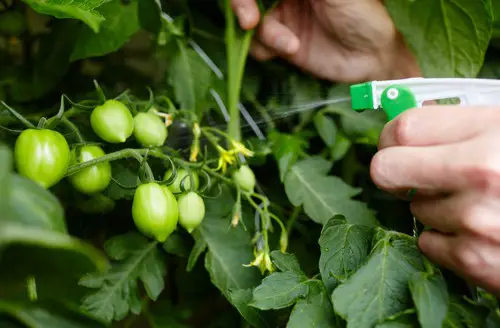
If your tomato plant is dying from top down, there are a few things you can do to revive it and bring it back to a healthy state.
First, check the roots of your tomato plant. If the roots are mushy, slimy, or have a foul odor, then root rot may be the cause of the problem. In this case, carefully remove the plant from the soil and trim away any damaged roots.
Repot the plant in fresh soil and water it well. Be sure to avoid overwatering the plant, as this can lead to further root damage.
If the roots are healthy, then the problem may be due to a lack of nutrients. Tomato plants require regular fertilization to thrive and produce fruit. Consider adding a slow-release fertilizer to the soil around the base of the plant. Alternatively, you can use a liquid fertilizer to feed the plant every two weeks.
Another possible cause of a dying tomato plant is a lack of sunlight. Tomatoes need at least 5 hours of sunlight a day to grow and stay healthy. If your plant is not getting enough sunlight, consider moving it to a sunnier location or adding supplemental lighting.
Finally, proper care and maintenance can go a long way in preventing tomato plant problems. Keep your plant well-watered, but avoid overwatering. Prune away any dead or damaged leaves and stems to promote healthy growth. Consider using a trellis or cage to support the plant and keep it upright.
Growing Tomatoes Successfully
Growing tomatoes successfully requires a bit of knowledge and care. Gardeners need to pay attention to the soil, water, sunlight, and other factors that can affect the growth and health of their plants. Here are some tips for growing tomatoes successfully:
1. Soil
Tomatoes need well-draining, nutrient-rich soil to grow properly. Gardeners should prepare the soil before planting by adding compost, manure, or other organic matter. They should also make sure the soil has a pH level between 6.0 and 6.8, which is ideal for tomato plants.
2. Water
Tomatoes need consistent watering to grow properly. Gardeners should water their plants deeply once or twice a week, depending on the weather and soil conditions. They should also avoid getting water on the leaves, which can lead to fungal diseases.
3. Sunlight
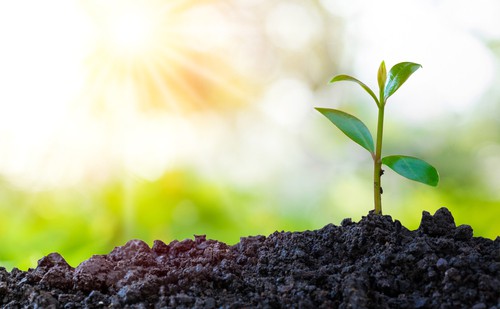
Tomatoes need at least six hours of sunlight per day to grow properly. Gardeners should plant their tomatoes in a spot that gets plenty of sun, and they should also make sure the plants have good air circulation to prevent diseases.
4. Fertilizer
Tomatoes need regular fertilization to grow properly. Gardeners should use a balanced fertilizer that contains equal amounts of nitrogen, phosphorus, and potassium. They should also avoid over-fertilizing, which can lead to excessive foliage growth and fewer fruits.
5. Care
Tomatoes need regular care to grow properly. Gardeners should prune their plants regularly to remove lower leaves and suckers, which can reduce air circulation and lead to diseases. They should also rotate their tomato crops every year to prevent soil-borne diseases.
6. Tomato Problems
Tomatoes can suffer from a variety of problems, including blight, yellowing leaves, and stem rot. Gardeners should inspect their plants regularly for signs of disease or pests, and they should take action promptly to prevent the spread of problems.
7. Tomato Varieties
There are many different varieties of tomatoes to choose from, including heirloom, cherry, and celebrity tomatoes. Gardeners should choose a variety that is well-suited to their growing conditions and tastes.
By following these tips, gardeners can grow healthy, productive tomato plants in their home garden, greenhouse, or containers.
Frequently Asked Questions
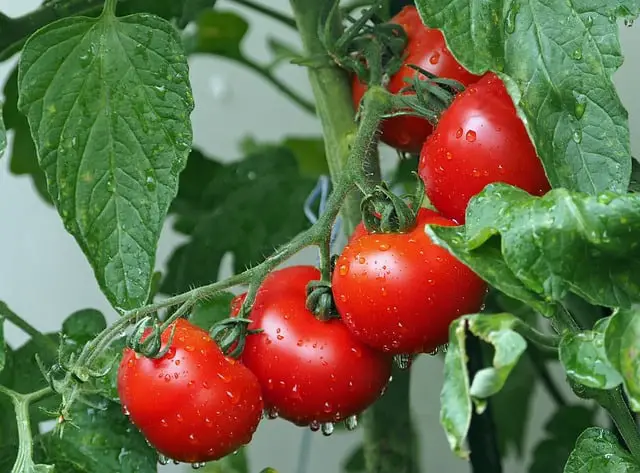
Why are my tomato plant leaves drooping and curling?
Drooping and curling tomato plant leaves are often a sign of stress caused by environmental factors such as lack of water, too much heat, or too much sun.
Overwatering or underwatering can also cause drooping and curling leaves. Check the soil moisture level and adjust watering accordingly. Providing shade during the hottest parts of the day can also help prevent stress.
How can I prevent my tomato plants from dying before the fruit ripens?
To prevent tomato plants from dying before the fruit ripens, it’s important to provide proper care from the beginning. Choose a location with well-draining soil and full sun.
Water regularly and deeply, but don’t overwater. Fertilize with a balanced fertilizer, and prune the plants as needed to improve air circulation. Also, keep an eye out for signs of disease and pests, and treat them promptly.
What are some treatments for tomato wilt?
Tomato wilt can be caused by a variety of factors, including fungal diseases such as Fusarium and Verticillium wilt. Treatment options depend on the cause of the wilt.
If the wilt is caused by a fungal disease, removing infected plants and treating the soil with a fungicide can help. If the wilt is caused by environmental factors, such as overwatering or underwatering, adjusting watering practices can help.
How can I prevent my tomato plants from dying from the bottom up?
Tomato plants can die from the bottom up due to a lack of airflow, fungal diseases, or nutrient deficiencies. To prevent this, prune the lower leaves of the plant to improve airflow and prevent fungal diseases.
Make sure the plants are getting enough water and nutrients, and avoid overfertilizing. Also, avoid planting tomatoes in the same location year after year, as this can lead to soil-borne diseases.
Is it possible for wilted tomato plants to recover?
It depends on the cause of the wilt. If the wilt is caused by environmental factors such as overwatering or underwatering, adjusting watering practices can help the plant recover.
If the wilt is caused by a fungal disease, removing infected plants and treating the soil with a fungicide can help. However, if the plant is severely wilted and has been affected by the disease for a long time, it may not be possible to save it.
How can I save a dying tomato plant?
To save a dying tomato plant, first determine the cause of the problem. If the plant is wilted, check the soil moisture level and adjust watering practices accordingly.
If the plant is affected by a disease, remove infected parts of the plant and treat the soil with a fungicide. Providing proper care, such as regular watering and fertilizing, can also help the plant recover.
However, if the plant is severely affected by disease or environmental stress, it may not be possible to save it.

Hey, I’m Lisa and I’ve been an avid gardener for over 30 years. I love writing, talking and living in the garden! Feel free to connect with me on my socials below

